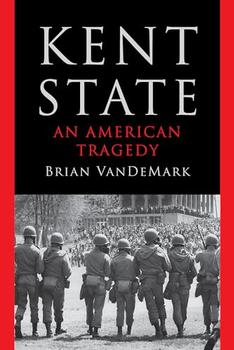Summary | Excerpt | Reviews | Beyond the book | Read-Alikes | Genres & Themes | Author Bio

An American Tragedy
by Brian VanDeMarkOn May 4th, 1970, four Kent State University students were shot and killed and nine wounded by members of the Ohio National Guard during a campus standoff. In Brian VanDeMark's stunning new study, Kent State: An American Tragedy, this "spasm of violence" receives a long overdue analysis essential to grappling with the incident's impact on America's psyche.
VanDeMark outlines early on why he felt this book was necessary: the Kent State shootings created "two competing narratives" that vilified either the student Vietnam War protesters or the Ohio National Guard for the tragedy that unfolded that day in northeast Ohio. VanDeMark sets out to tell the story from multiple perspectives, "without taking sides," using previously untapped archival documents and interviews with those who were there. The result is a cogent, clear-eyed, and almost minute-to-minute account of the chaos that erupted when young people on both sides of an American cultural divide squared off on the quad of Kent State.
The book begins with a snapshot of "the divided America of 1970" and how it came to be that way. American soldiers had entered Vietnam in the mid-1960s under the Kennedy administration and the war had expanded under Johnson, leading to increasing anti-war protests among the country's college youth. In December 1969, the first draft lottery since WWII was held; and a few months later, in late April 1970, Nixon announced he would send American troops into Cambodia for a limited incursion, which inflamed college students across the country, especially eligible males, who felt their nonviolence protests availed them nothing. Over this time, Kent State, like other colleges, had evolved from "quiet provincialism" into a hotbed of anti-war activism.
Kent State then goes into the events of the three days leading up to the shooting (May 1st through May 3rd) as seen and experienced by both student protestors and several Ohio National Guardsmen. After students set fire to the Kent State ROTC building, "a symbol of the military-industrial complex they despised and a constant reminder of the war in Vietnam they hated," the Guard was called out by the mayor, who felt the Kent police force was not equipped to deal with the growing unrest. The Guardsmen were mostly in their twenties, and many were sympathetic to the protestors; according to VanDeMark, many had joined the Guard to avoid the draft. "They saw themselves as reluctant participants," VanDeMark writes, but students saw them far differently; some protestors hurled verbal epithets at them, as well as rocks and debris.
May 4th, the "tragic day," is exhaustively covered with nerve-shredding tension as VanDeMark describes the chaos and confusion that swirled around the Guard regiments (led by General Robert Canterbury, whose incompetence and dismal leadership jumps off the page). In answer to the historical question surrounding the Kent State shooting of why the National Guard started firing on protestors who were unarmed and far away, VanDeMark posits that no one gave a command to fire, and that the shooting can be traced to a warning shot by an enlisted man, who shares his story for the first time in this book. The narrative is as gripping as it is comprehensive.
VanDeMark also chronicles the aftermath of the shooting, focusing on the psychological and emotional trauma suffered by the student survivors, the Ohio soldiers, and the families of those killed. He includes vivid and sensitive portraits of the thirteen students who were shot and killed or wounded, and shows how the lives of the survivors were changed forever. He also liberally documents the cold-hearted reactions of locals after the shooting, exploring the "town-and-gown" tension in Kent that bordered on hatred and left the townspeople blaming the students for the unrest. By gathering all of these perspectives, Kent State eschews simplified narratives of the tragedy that unfolded in 1970.
![]() This review
first ran in the September 18, 2024
issue of BookBrowse Recommends.
This review
first ran in the September 18, 2024
issue of BookBrowse Recommends.

If you liked Kent State, try these:

by Candace Fleming
Published 2025
How did Jim Jones, the leader of Peoples Temple, convince more than 900 of his followers to commit "revolutionary suicide" by drinking cyanide-laced punch? From a master of narrative nonfiction comes a chilling chronicle of one of the most notorious cults in American history.

by Paul Auster
Published 2025
An intimate and powerful rumination on American gun violence by Paul Auster, one of our greatest living writers and "genuine American original" (The Boston Globe), in an unforgettable collaboration with photographer Spencer Ostrander
Your guide toexceptional books
BookBrowse seeks out and recommends the best in contemporary fiction and nonfiction—books that not only engage and entertain but also deepen our understanding of ourselves and the world around us.